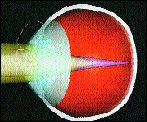Predicting Post-Refractive
Surgery Patient Satisfaction
By Brian S. Boxer Wachler, M.D.
SEPT. 1997
Imagine that refractive surgeons could use a contact lens to predict how satisfied their patients would be after refractive surgery. Currently, there's no method to preoperatively identify patients who may experience complications such as glare and halos following treatment, but I've designed a contact lens that can simulate the visual consequences likely to occur.
PUPIL SIZE & ABLATION ZONE
When a refractive surgery patient's pupil dilates beyond the area of refractive change, the light rays entering the pupil become focused at two different points in the eye, one point on and one off the retina (Fig. 1). As a result, the patient experiences halos. In the United States, for example, where the approved PRK ablation zone is a maximum of six millimeters, patients whose pupils expand to a diameter greater than six millimeters can potentially be unhappy postsurgically.
Glare, another potential problem, occurs when the area of refractive change is the same size or bigger than the pupil, but light rays are able to enter the eye off-axis (outside of the central refractive area).
During the preop screening, refractive surgeons should take into consideration the largest pupil diameter, but I believe that this is currently not a standard of care because infrared pupillometers are cost-prohibitive. Even doctors who assess nocturnal pupil size clinically may not obtain an accurate measurement because the iris is a dynamic structure and may fluctuate in response to medications, emotional status or other variables. The ideal assessment is one that allows the patient to detect visual disturbances in the real-life scenario.
|
VIRTUAL POSTOP
The contact lens design I am proposing includes a central area of refractive power surrounded by a plano or near-plano annulus. The diameter of the central area represents the ablation diameter. Surgeons will be able to choose from a diagnostic kit of various ablation zone diameters and refractive powers to simulate the potential outcome of the proposed procedure.
Even patients who have a pupil diameter larger than the ablation zone diameter available may still qualify as candidates, depending upon their tolerance for the resulting visual phenomena. In regions where many ablation zone diameters are available, the lens can help surgeons customize the ablation diameter according to laser capability.
REALISTIC EXPECTATIONS
The ability to preoperatively demonstrate to the patient the likely surgical outcome adds new depth to the phrase "informed consent." Patients often take a long time to make a decision about having refractive surgery. They shop around and gather as much information as possible. The practitioner who can provide the patient with realistic surgical insight will set himself apart from those who cannot. It's also likely the lens will help expedite the patient's decision-making process.
ON THE AGENDA
The patent of this contact lens design and diagnostic kit is pending. The next step is to team with a contact lens manufacturer to develop a prototype which will be studied during my cornea and refractive surgery research fellowship with Daniel S. Durrie, M.D. My goal is to develop and provide practitioners with a comprehensive kit of contact lenses that simulate the postsurgical effects of all refractive surgery procedures, including intracorneal stromal rings and phakic intraocular lenses. CLS
Dr. Boxer Wachler is the cornea and refractive surgery fellow at the Kansas University Medical Center and Hunkeler Eye Center in Kansas City.
Direct all inquiries to Dr. Boxer Wachler at (816) 931-4733.




